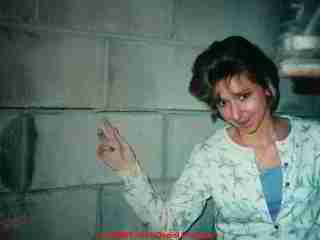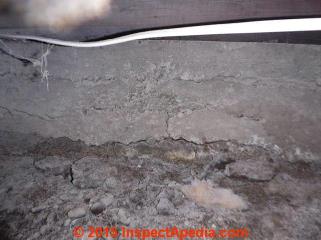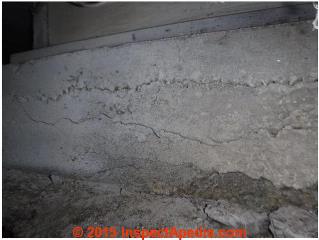 Foundation Damage & Repair FAQs
Foundation Damage & Repair FAQs
Q&A on Assessing Foundation Cracks, Leans, Bulges, Settlement
- POST a QUESTION or COMMENT on how to evaluate, diagnose, & repair foundation cracks, leans, bulges, movement, damage
Q&A about assessing types of foundation damage.
This article series describes in detail how to recognize, diagnose & repair various types of foundation failure or damage, such as foundation cracks, masonry foundation crack patterns, and moving, leaning, bulging, or bowing building foundation walls.
InspectAPedia tolerates no conflicts of interest. We have no relationship with advertisers, products, or services discussed at this website.
- Daniel Friedman, Publisher/Editor/Author - See WHO ARE WE?
FAQs on Methods & Procedures for Evaluating Foundation Cracks, Movement, & Condition
 These questions & answers about assessing types of foundation damage and movement and its repair were posted originally
These questions & answers about assessing types of foundation damage and movement and its repair were posted originally
at FOUNDATION CRACKS & DAMAGE GUIDE - home; that's a good place to start.
Reader Question: are these horizontal foundation cracks "cosmetic" or "damage" ?
2016/05/11 Jing said:
I am buying a house (built in 1965) that has several horizontal cracks (2-3, about 6 feet long) in the concrete foundation in the crawl space. I asked a foundation consultant to do an inspection on the house.
He checked the leveling of each room with his tool and also went into the crawl space to look at these cracks. After that I was told that the house is in good shape and the cracks are hairline like and thus no concern. When I asked whether I need to fix the cracks, he told me no.
But I am still concerned about these cracks since I saw many people say horizontal cracks can be problematic because moisture can go in and then the steel can have corrosion and expansion and finally the concrete foundation can collapse.
I have no knowledge on house structure and thus would like to get a second opinion on this.
The inspection contingency is expiring soon and I do not have time to ask another guy to do another round of inspection.
[Here] are several images. It seems to me these cracks are not hairline like.
Reply: Cold pour joints are not damage, but if cold pour joints + poor concrete mix yield an un-stable wall there could be leaks, movement, or other problems with the foundation
Jing, your images of "concrete cracks" look to me like cold-pour joints rather than cracks caused by bending, sagging, settling or other forces on concrete.
The concrete work looks a bit sloppy and possibly the concrete mix was poorly made. One image included a discontinuous horizontal crack that looks like a shrinkage crack (photo above) but is probably one that occurred as the cold pour joint cured.
If the cold pour joints in a concrete foundation wall are unusually open you may find water leaking through the wall (fix that problem outside first) and if earth or other forces from outside the foundation wall are significant, a concrete foundation wall might bend or buckle along the cold pour joint - though that's something I've never seen myself in 40 years of foundation inspections.
It would make sense to make a more careful measurement of leaning or bending in this foundation wall.
See BULGE or LEAN MEASUREMENTS (found by searching InspectApedia for FOUNDATION LEAN MEASUREMENT).
Just below on this page you'll see a list of articles on foundation damage assessment.
Also in the ARTICLE INDEX to BUILDING STRUCTURESS (live link below) you'll find a complete index to types of foundations and foundation damage, including this article that is a "must read" considering the photos you submitted:
Reader follow-up: cold pour joints are not horizontal foundation cracks
Dan, thank you very much for your reply, you are so fast!
So if I understand you correctly, these (relatively bigger) cracks are cold pour joints but not real horizontal cracks. And it seems to me like if no leaking issue is present here, probably there is nothing to fix, which is consistent w/ what our inspector says.
One suggestion I got from him is to keep the crawl space dry. I think this should be true for all houses.
I have posted a few more pictures in the following link. Would you please have a look at them? In case you see anything unusual please do let me know.
I really like this website, a lot of useful info and also very quick reply! Thank you so much!
Moderator reply:
Take a look at our discussion in the article above where you see your photos, Jing and you'll see a link to COLD POUR JOINTS - be sure to take a look there if you haven't done so. Your photos are (mostly) sharp up-close images; stand back and look at the concrete pattern and you may recognize cold pour joints.
However your picture #6 looks a bit like an open crack in an old concrete wall. I can't tell from this perspective if I'm looking at just an open cold pour joint or, as I suspect, someone's prior patch attempt on the wall.
Have your home inspector or other building experts look further as I advised for leaning, bowing, bulging, water entry. If none of those are observed, and if they confirm that these are cold pour joints, then the foundation isn't moving and there has been no foundation issue demonstrated by these clues.
Reader follow-up: so are these cracks indicating structral problems or not?
Jing said:
Thanks again for your quick response. That's very helpful. We need to decide tomorrow, so we don't have time to have a profession come to the site. You mentioned that leaning, bowing or bulging will be a big concern along with the cracks.
My foundation consultant gave us a chart showing the leveling of the house, please see the picture I provided. Is it able to tell from this chart that, the house doesn't have settlement movement, and these cracks are not structural problems? Thank you very much!
Moderator reply:
Jing,
I've said as much as I can speculate based on just your photos. That is enormously less information than one would see at an on-site inspection.
Watch out: The most-upset home buyers I ever find are those who are forced by circumstance to run towards a property screaming I WANT IT and throwing their wallet and checkbook ahead of themselves.
That's because in the rush to close people do hasty work, make mistakes, or fail to understand the building they are buying. Sometimes they're upset later by what are described as "big surprises".
While nobody should make up hazards to the detriment of a property seller, the buyer should exercise all due diligence - that's standard advice in real estate transactions.
You should not and cannot rely on brief e-text to a stranger or a website to make multi-thousand purchase decision on a home. You need an on-site expert whom you can trust completely, who has true expertise and experience where needed, and who has no conflicts of interest regarding the transaction, seller, realtor, or buyer.
I have said as much as I can see from your photos; I certainly cannot tell from your posted photos what is the overall condition of the home, its foundation, nor the rest of its structure.
I do not agree that simply determining that the floors in a home are level means there has been no foundation movement. There could be prior repairs that are or are not adequate, additoinal leveling and shimming that have been done that are ok or not ok, ongoing or not -ongoing foundation movement.
I can't see that nor answer those questions from your photos. But those questions can be answered by an on-site expert. Enormously more information is available to a competent home inspector or other on-site building professional.
Question: after a foundation company installed a foundation the back door won't shut correctly and the concrete blocks are cracking all around the house
My mother decided after 3 yrs it was wise to install block foundation. A company installed her foundation with block. then she noticed her back door was shutting correctly and the block all around the house was cracked.
She called this company back and he proceeded to fix it saying his concrete was probably bad and reported it to his insurance. After a couple of weeks after he so called fix it the home has bad cracks again and the door never fixed correctly. I feel there taking advantage of my mothers no knowledge.
Can you help with advise or what is the correct procedure thx.
I apologize correction: kitchen door was NOT shutting correctly..
- Elsa Lopez
Reply:
Elsa, take a look at the types of foundation cracking, causes, repairs, beginning at FOUNDATION CRACKS & DAMAGE GUIDE. With so little information I cannot guess accurately about what went wrong. We'd need a lot of information about what was already there, what problem was being solved, and what work was done.
In other words, before we can begin even thinking about a foundation repair (other than perhaps emergency support in dire cases), we need to know
- the extent of building movement and damage
- the effects of those events on the structure
- the cause(s) of the movement
But in any case I agree that foundation cracking all around a house sounds like a serious mistake that needs to be diagnosed accurately before any further amateur repair work is undertaken.
You might find a foundation expert in our EXPERTS DIRECTORY or among local foundation repair companies or from an engineering firm PROVIDED the engineer actually has personal experience with residential building foundation inspection, diagnsosis, and repair.
Keep us posted.
Comment:
(Aug 20, 2011) Basement flooding said:
Research shows that almost 100% of all basements will suffer some form of basement flooding at some point in their existence.
“Almost 100%” translates into “it’s certain”. It makes sense, too, because basements are the single lowest location in any structure, and excess water is always going to flow downhill. Put the two together and you have an unwelcome flooded basement.
Question:
(Nov 5, 2011) Anonymous said:
My home is not on ground and it has concrete walls everytime earth movement accures I get cracks on walls what can I do to prevent this from happening?
Question:
(Nov 15, 2011) jan said:
my 3 bed loft conversion (which was already done,when I moved in)needs some strengthening works done to the floor and walls, please could I have a ball park figure of what this could cost me ?
Question:
(Jan 5, 2012) Sheryl said:
I own a very large manufactured home. Since I moved in a year ago I've noticed some cracking around the ceiling area where some of the sections were joined together; especially after I had new roofing put on. Could all the banging and thumping caused some of this?
Reply:
Sheryl, in my OPINION, the answer is a definite "maybe" -
Depending on the home's roof framing and covering, the roof and ceiling might indeed flex during work above, moreso if the contractor piled a heavy weight of roof covering materials in one spot.
Question:
(Mar 7, 2012) Colleen said:
Unlicensed roofing company, shoddy repair, holes in roof, tore off gutters and plucked out all insulation in attic plus electricity. Foundation has been weakened. Walls cracking, floors shifting and dropping. HELP!
Reply:
Colleen: from your note it sounds as if you need an onsite expert who is professional, thorough, expert, and unbiased, and who can inspect and document what conditions you face and recommend what repair steps are needed.
This is not something you should handle by webmail. The EPERTS DIRECTORY at page top may help you find someone, or check with your local better business bureau.
That said, frankly I can't imagine wat a roofer could have done that would cause foundation damage and cracking shifting walls - it sounds as if something more basic is going on.
Finally, if there is significant movement or if you have any reason whatsoever to be worried about a possible building collapse, you should go outside, get others out of the building, and call your local fire department for help.
Question:
(Oct 4, 2012) Richard Brummell said:
We are somewhat disappointed with hair line crack in foundation 1 week after pouring.
Reply:
Richard,
See our article about shrinkage cracking and perhaps that will assist you.
Question:
6/16/14 David said:
I live an 3-floor apartment building, bottom floor, and have begun to notice quite a few cracks in the concrete walls of my apartment. The walls are not cement all the way through but hollow, that's all I know I'm afraid.
Most cracks are quite narrow and they are found mostly near doors or other openings, except for one which runs from the ceiling to the floor. The majority of them are vertical or diagonal.
There might have been an addition to the building last year, a metal roof I believe. There is a door that has started to act oddly, sort of opening itself if pushed beyond a certain point. The landlord isn't the type who's gonna do more than fill or paint over the cracks if informed. Is it safe for me to stay in this apartment? Is the building going to collapse? Or can I wait and see?
Reply:
David,
If a building is moving or settling enough that doors stop working I'm concerned that it may be unsafe. Even if there were no imminent risk of collapse, a stuck door is a fire-exit hazard that should not be ignored.
I can't assess collapse risk from just your note;
Notify the landlord in writing of your concerns that include both building structure and fire safety.
...
Continue reading at FOUNDATION DAMAGE REPORTS or select a topic from the closely-related articles below, or see the complete ARTICLE INDEX.
To understand the cause, effect, and remedy for all types of building foundation or masonry wall damage or movement we have categorized foundation damage into these broad categories:
- FOUNDATION DAMAGE & REPAIR GUIDE: home page for foundation damage assessment & repair procedures.
- FOUNDATION CRACK DICTIONARY, what is the severity of foundation damage, what is its effect on the stability of the structure, and how urgently are foundation repairs needed?
- FOUNDATION FAILURES by MOVEMENT TYPE: is the movement active or not, how is the foundation moving: bulging, leaning, settling, etc. ?
- FOUNDATION FAILURES by TYPE & MATERIAL: how does damage show up in different types of foundation material & what are the implications for collapse risk or repair need?
- FOUNDATION REPAIR METHODS discusses alternative ways to fix a damaged foundation or floor slab crack or movement
Suggested citation for this web page
FOUNDATION CRACKS & DAMAGE GUIDE FAQs at InspectApedia.com - online encyclopedia of building & environmental inspection, testing, diagnosis, repair, & problem prevention advice.
Or see this
INDEX to RELATED ARTICLES: ARTICLE INDEX to BUILDING STRUCTURES
Or use the SEARCH BOX found below to Ask a Question or Search InspectApedia
Ask a Question or Search InspectApedia
Try the search box just below, or if you prefer, post a question or comment in the Comments box below and we will respond promptly.
Search the InspectApedia website
Note: appearance of your Comment below may be delayed: if your comment contains an image, photograph, web link, or text that looks to the software as if it might be a web link, your posting will appear after it has been approved by a moderator. Apologies for the delay.
Only one image can be added per comment but you can post as many comments, and therefore images, as you like.
You will not receive a notification when a response to your question has been posted.
Please bookmark this page to make it easy for you to check back for our response.
IF above you see "Comment Form is loading comments..." then COMMENT BOX - countable.ca / bawkbox.com IS NOT WORKING.
In any case you are welcome to send an email directly to us at InspectApedia.com at editor@inspectApedia.com
We'll reply to you directly. Please help us help you by noting, in your email, the URL of the InspectApedia page where you wanted to comment.
Citations & References
In addition to any citations in the article above, a full list is available on request.
- [1] New York State Department of Engineering, correspondence. D. Hasbrouck, P.E. to DJF.
- In addition to citations & references found in this article, see the research citations given at the end of the related articles found at our suggested
CONTINUE READING or RECOMMENDED ARTICLES.
- Carson, Dunlop & Associates Ltd., 120 Carlton Street Suite 407, Toronto ON M5A 4K2. Tel: (416) 964-9415 1-800-268-7070 Email: info@carsondunlop.com. Alan Carson is a past president of ASHI, the American Society of Home Inspectors.
Thanks to Alan Carson and Bob Dunlop, for permission for InspectAPedia to use text excerpts from The HOME REFERENCE BOOK - the Encyclopedia of Homes and to use illustrations from The ILLUSTRATED HOME .
Carson Dunlop Associates provides extensive home inspection education and report writing material. In gratitude we provide links to tsome Carson Dunlop Associates products and services.


